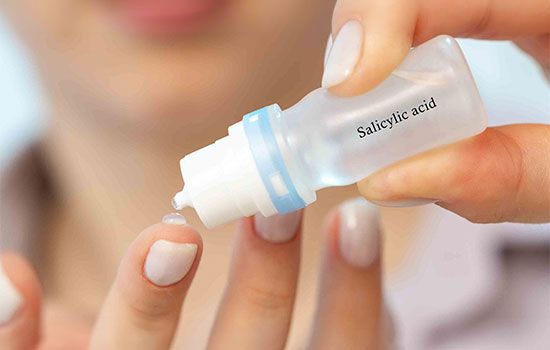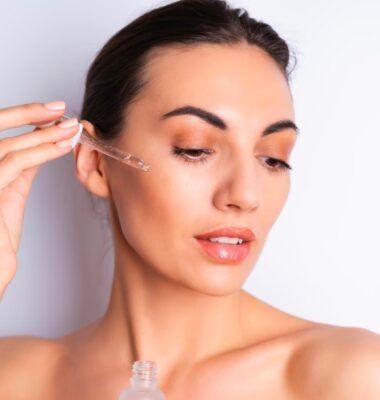Salicylic Acid Skincare Guide: Unlocking the Secrets to Clear, Radiant Skin
Fact checked
By Andrea Pinto Lopez, MD | General Practitioner
Last Updated on June 9th, 2025 / Published on February 20, 2025

We all know the feeling: waking up one morning with an unexpected pimple or blemish on our skin. And, even worse, not knowing how to make it go away.
The skin is our largest organ. So, it’s no wonder skin concerns are common. One in three Americans1 have skin problems at any given time.
But even though skin issues are frustrating, using the right ingredients in your skincare routine can make a world of difference.
Salicylic acid is one of the most common ingredients in skincare, and for good reason! This single ingredient treats acne, psoriasis, dermatitis, calluses, and other common skin issues.
Finding the right salicylic acid may seem confusing since many options are available. In this article, we’ll discuss when to use salicylic acid in your skincare routine. We’ll also talk about some of our favorite products. Keep reading to learn more!
Salicylic Acid 101: What is Salicylic Acid?
Salicylic acid is part of a group of medications called salicylates. It’s closely related to acetylsalicylic acid — commonly known as aspirin. But unlike aspirin, salicylic acid is only used as a topical treatment.
Salicylic acid can also be classified as a keratolytic agent. This is because it removes and softens dry skin, helping it fall off more easily to reveal healthy skin.
Salicylic acid acts as a beta-hydroxy acid (BHA). This is a mild exfoliant that removes dead cells from the skin’s surface. Salicylic acid works as an exfoliant by breaking down layers of thick skin,2 while also reducing redness, swelling, and inflammation. Different products contain salicylic acid. Examples include creams, lotions, wipes, ointments, shampoos, and gels.
Since it helps reduce thickened or overgrown skin, salicylic acid prevents and relieves numerous skin problems, including:
- Acne
- Psoriasis
- Calluses or corns
- Common and plantar warts
- Dandruff
- Ichthyoses (a group of genetic disorders that causes dry, scaly skin)
Topical salicylic acid skincare products come in various forms and strengths, depending on your specific needs and preferences.
Some forms of salicylic acid are only available as a prescription.3 This is because they may be too strong for people who have never used it before. You may have adverse reactions to these formulations, so ask your doctor before use.
3 Major Benefits of Salicylic Acid for the Skin
1. It exfoliates and renews your skin
Salicylic acid works as a keratolytic or peeling agent.4 This means it can speed up the shedding of the outer layers of your skin.
As a result, salicylic acid helps you:
- get rid of dead skin cells
- renew and brighten your skin
- improve your skin’s texture
2. It combats acne and breakouts
Dead skin cells can obstruct your pores and lead to pimples and acne. Here’s how salicylic acid fights acne and breakouts:
- Due to its exfoliating action, salicylic acid treats5 whiteheads and blackheads.
- Salicylic acid has anti-inflammatory properties. Inflammation is a normal response triggered by the immune system to protect you against potential damage. Inflammation can cause redness, swelling, heat, and pain in any part of your body. Salicylic acid helps relieve these symptoms (found in inflammatory acne) because it counteracts skin inflammation.
It’s important to remember that these benefits don’t become apparent overnight. You’ll need to use salicylic acid consistently for a few weeks to see full results.
3. It reduces excess oil and unclogs pores
Salicylic acid is oil-soluble. This means it can break down oils to penetrate deeper into your skin. As a result, it decreases skin sebum.6 Skin sebum is an oily coat produced by glands in your skin. Sebum prevents your skin from drying out but can also accumulate and block your pores.
Therefore, using salicylic acid regularly can reduce excess oil on your skin and unclog your pores, leading to fewer breakouts.
Best Salicylic Acid Products for Every Skin Type
Many salicylic acid skincare products are available. So, choosing the right product for your skin needs may seem difficult.
Let’s review some of our favorite skincare products with salicylic acid.
Cleansers, Toners, and Serums
- CeraVe SA Cleanser: Besides salicylic acid, this affordable cleanser contains hyaluronic acid, niacinamide, and vitamin D to moisturize and exfoliate your skin.
- Paula’s Choice CLEAR Pore Normalizing Cleanser: This product contains less salicylic acid, making it safe for sensitive skin while still unclogging your pores.
- Neutrogena Oil-Free Acne Fighting Facial Cleanser: This oil-free formula also contains other helpful ingredients, such as aloe vera and chamomile extracts, to clean your skin without irritating it.
- La Roche-Posay Effaclar Clarifying Solution Acne Toner: This toner can be used after cleansing your face to remove excess oil and dead cells, promoting smoother skin.
- Bioré Witch Hazel Pore Clarifying Toner: This toner also contains witch hazel, a powerful ingredient that further decreases inflammation and acne.
- Olay Salicylic Acid Serum: This unscented formula doesn’t include any parabens, phthalates, dyes, or oils, which makes it a great choice for sensitive skin.
- IT Cosmetics Bye Bye Breakout 2% Salicylic Acid Serum: This serum also contains lactic acid, a gentle exfoliant, and postbiotic ferments to support balanced, smooth skin.
Moisturizers and Spot Treatments
- Neutrogena Oil Free Acne Facial Moisturizer: This moisturizer also contains natural grapefruit extract, full of antioxidants that help brighten and soothe your skin.
- Thayers Blemish Clearing Salicylic Acid and Witch Hazel Acne Face Moisturizer: This moisturizer contains tons of healthy natural ingredients, such as aloe vera, tea tree oil, and lemongrass extract.
- CeraVe Salicylic Acid Acne Treatment with Glycolic Acid and Lactic Acid: This spot acne treatment also contains ceramides to help maintain the skin’s natural barrier.
- Clean & Clear Advantage Acne Spot Treatment: This product’s salicylic acid and witch hazel target acne and can be used on all skin types at an affordable price.
- Amazon Basics Advanced Blemish Spot Treatment: Another great and affordable option, this spot treatment contains many beneficial ingredients, including salicylic acid, glycolic acid, lactic acid, and ceramides.
Masks and Peels
- Neutralyze Deep Pore Cleansing Face Mask: This mask combines the effects of bentonite clay, salicylic acid, and bakuchiol, a plant-derived retinol alternative.
- Paula’s Choice Skin Perfecting 2% BHA Liquid Salicylic Acid Exfoliant: you don’t have to wash this leave-on liquid exfoliant off, simplifying your skincare routine while still providing the benefits of salicylic acid.
- Tamoskiny Anti Acne Face Mask: This pack of 10 face masks is an affordable option with mild ingredients suitable for all skin types, and it comes in a wide array of options to choose from depending on your skin’s needs.
- Perfect Image Salicylic 20% Gel Peel, Breakout and Pore Minimizer and Cleanser: This at-home face peel is infused with green tea and tea tree extract to nourish your skin, as the salicylic acid exfoliates.
- Skin Beauty Solutions SALICYLIC Acid Peel 30%: This powerful formula contains 30% salicylic acid. You can use it every few weeks to get rid of dead skin cells, unclog your pores, and rejuvenate your skin.
- QRxLabs Salicylic Acid 20% Gel Peel: This formula comes as a light gel, making it easier to target specific areas of your face without having the product drip or slip. It also releases the salicylic more slowly to reduce the risk of irritation.
How and When to Use Salicylic Acid in Your Skincare Routine
Should I Use Salicylic Acid in My Morning vs. Nighttime Skincare?
You can maximize the benefits of salicylic acid if you know when to incorporate it during your day. Timing your use can also decrease the risk of adverse effects.
You can use salicylic acid safely in your morning and nighttime skincare routines. But since it can make your skin more sensitive to the sun,2 wear protective clothing and sunscreen while using it — especially if you’re applying your salicylic acid products in the morning.
Also, you can use a cleanser that contains salicylic acid in the mornings. It will help remove any dead skin cells from the night before. You can add other nourishing ingredients to your morning routine, such as vitamin C, niacinamide, and hyaluronic acid.
How Often Should Salicylic Acid Be Used?
This depends on several factors, such as:
- The type of product you’re using
- The concentration of the salicylic acid in the product
- The reason why you’re using salicylic acid
Common dosage frequencies for salicylic acid7 include:
- For corns, calluses, and common warts: once a day, for 3-5 days
- For acne: one to three times a day
- For psoriasis: once a day
- For dandruff and anti-seborrheic dermatitis of the scalp: one or two times a day
Steps to Follow When Applying Salicylic Acid Products
If your healthcare provider prescribed salicylic acid to treat a skin condition, follow the directions on the package. This is especially important if you’re using a product with a higher concentration of salicylic acid rather than an over-the-counter skincare product.
For specific skin conditions, such as warts, your doctor may tell you to apply salicylic acid for a particular time, for up to several weeks or months.
You should do a patch test with your new salicylic acid skincare products. To do this, apply a small amount of the product to your skin (preferably on the inside of your arm). Then, wait 10–15 minutes to see if you develop any allergic reaction.
To apply salicylic acid, follow these steps:
- First, clean the area with a mild cleanser.
- Make sure to follow the instructions on the product’s label.
- Unless you’re treating your hands with salicylic acid, wash them after applying the product.
- Keep products with salicylic acid away from your eyes, mouth, and other mucous membranes.
If you miss a dose, try to apply it as soon as possible. But if it’s almost time for your next application, skip the missed dose and continue your regular schedule.
Comparing Skincare Acids: Salicylic Acid vs. Others
Salicylic Acid vs. Glycolic Acid: Understanding the Differences and Uses
Glycolic acid is an alpha hydroxy acid (AHA) in many skincare products. It helps improve skin luminosity and hyperpigmentation.8 It’s also an exfoliant that can improve skin texture.
Both salicylic acid and glycolic acid can help treat acne. However, salicylic acid is typically a better choice for acne-prone skin.
Hyaluronic Acid vs. Salicylic Acid: Understanding the Differences and Uses
Although it’s also called an acid, hyaluronic acid doesn’t exfoliate your skin. Instead, it plays an important role in9 skin repairing, wound healing, combating inflammation, and regenerating tissues. As a result, it’s most often used as a powerful moisturizer.
So, if you’re choosing between hyaluronic acid versus salicylic acid for conditions such as acne, warts, or calluses, salicylic acid is your best bet.
Potential Side Effects and Precautions
Like any other medication, salicylic acid can interact with other treatments or cause certain adverse effects.
Common Side Effects of Salicylic Acid
As with any new skincare ingredient, it’s a good idea to check with your dermatologist to make sure the new product won’t interact with other treatments or medications you’re taking.
Some common side effects of salicylic acid can include:
- Skin irritation
- A feeling of stinging on the skin
If you notice any of the following symptoms, please seek medical attention immediately. These could be signs that you’re having an allergic reaction to salicylic acid:
- Hives
- Itching
- Dizziness
- Ringing or buzzing in the ears
- Difficulty breathing
- Feeling faint
- Swelling of the eyes, lips, face, or tongue
- Nausea or vomiting
- Diarrhea
- Throat tightness
Who Should Avoid Salicylic Acid?
Dermatologists don’t recommend salicylic acid for children under 12 years old.
It may also be harmful if you have kidney or liver disease. These conditions increase your risk of having side effects.
Some of the medications that interact with salicylic acid10 include:
- Adapalene
- Alitretinoin
- Bexarotene
- Clascoterone
- Isotretinoin
- Tazarotene
- Tretinoin
- Trifarotene
These medications cause mild interactions with salicylic acid and can increase skin sensitivity, inflammation, or dryness in the treated area.
Discuss any new treatments with your dermatologist; they’ll guide you to create an adequate skincare routine that fits your needs but doesn’t include ingredients that interact with salicylic acid.
How to Use Salicylic Acid Safely
Salicylic acid makes your skin more sensitive to the sun. You must limit your sun exposure while using salicylic acid skincare products. And while you should always use sunscreen, it’s crucial while using salicylic acid.
Also, avoid tanning beds or booths if you’re using salicylic acid. Wear protective clothing if you need to be out in the sun. Avoid getting salicylic acid in your eyes, nose, or mouth. If this accidentally happens, rinse the affected area with fresh water for approximately 15 minutes.
You may notice that your skin becomes drier or more sensitive after you start applying salicylic acid. To prevent this, use only a small amount of salicylic acid until your skin gets used to this new product. Also, avoid applying this product to injured, red, swollen, infected, or irritated skin.
Frequently Asked Questions (FAQs)
-
Can Pregnant or Breastfeeding Women Use Salicylic Acid?
Over-the-counter salicylic acid products usually contain lower amounts of acid. They’re generally safe when pregnant.11 But if you have doubts about your skincare routine during pregnancy, check with your doctor to find the best options for you and your baby.
-
How Long Does It Take to See Results with Salicylic Acid?
Salicylic acid doesn’t act instantly, so you’ll need to use it for a few days or weeks to see its full results, depending on the skin issue you’re targeting.
For example, warts may need 12 weeks of treatment. But, salicylic acid pads or serums that target acne can take 4 to 6 weeks to show full results.
-
Is Salicylic Acid Suitable for Sensitive Skin?
Salicylic acid is ideal for oily and acne-prone skin. But anyone can benefit from salicylic acid. You just have to find the right product for you.
If you have sensitive skin, we recommend only using salicylic acid a few times weekly and incorporating more hydrating products in your skincare routine.
Takeaway
Salicylic acid is a powerful skincare ingredient that comes in many presentations, both over-the-counter and with a prescription. It speeds up skin renewal, helps shed dead skin cells, unclogs your pores, reduces oil production, and combats acne breakouts and pimples. Because of this, it can be a great way to boost your skincare routine — and the good news is that many affordable salicylic products are available.
Using the right product for your specific needs is important since different products treat diverse skin conditions. Using the wrong product can increase the risk of side effects, such as skin sensitivity or redness. To prevent these, applying sunscreen daily is essential (which you should always do!)
Discussing your skin concerns with a dermatologist is helpful. They can help you choose the best salicylic product acid for your skincare routine. With constant use, salicylic acid can boost your skin radiance and help you get rid of those pesky blemishes in no time.
Sources
- Skin conditions at a glance. National Center for Complementary and Integrative Health. November 2019. https://www.nccih.nih.gov/health/skin-conditions-at-a-glance
- Salicylic acid: Uses, brands & interactions. Cleveland Clinic. September 15, 2016. https://my.clevelandclinic.org/health/drugs/20341-salicylic-acid-topical-gel-cream-lotion-solution
- Salicylic acid topical: Medlineplus Drug Information. MedlinePlus. November 15, 2016. https://medlineplus.gov/druginfo/meds/a607072.html
- Salicylic acid topical uses, side effects & warnings. Drugs.com. 2023. https://www.drugs.com/mtm/salicylic-acid-topical.html
- ADULT ACNE TREATMENT DERMATOLOGISTS RECOMMEND. American Academy of Dermatology. January 10, 2023. https://www.aad.org/public/diseases/acne/diy/adult-acne-treatment
- Lu J, Cong T, Wen X, et al. Salicylic acid treats acne vulgaris by suppressing AMPK/SREBP1 pathway in sebocytes. Exp Dermatol. 2019;28(7):786-794. doi:10.1111/exd.13934
- Salicylic acid (topical route) proper use. Mayo Clinic. September 1, 2023. https://www.mayoclinic.org/drugs-supplements/salicylic-acid-topical-route/proper-use/drg-20066030
- Houshmand EB. Effect of glycolic acid, phytic acid, soothing complex containing Emulsion on Hyperpigmentation and skin luminosity: A clinical evaluation. J Cosmet Dermatol. 2021;20(3):776-780. doi:10.1111/jocd.13950
- Bukhari SNA, Roswandi NL, Waqas M, et al. Hyaluronic acid, a promising skin rejuvenating biomedicine: A review of recent updates and pre-clinical and clinical investigations on cosmetic and nutricosmetic effects. Int J Biol Macromol. 2018;120(Pt B):1682-1695. doi:10.1016/j.ijbiomac.2018.09.188
- Salicylic acid topical interactions. Drugs.com. https://www.drugs.com/drug-interactions/salicylic-acid-topical.html
- Drugs and Lactation Database (LactMed®) Bethesda (MD): National Institute of Child Health and Human Development; 2006. Salicylic Acid. [Updated 2021 Jun 21]. https://www.ncbi.nlm.nih.gov/books/NBK500675/





